
9 Morning Breathing Exercises for Relaxation and Stress Management
Have you ever been told to take a deep breath after becoming visibly anxious around peers or loved ones? Chances are, you have.
As you likely already know, controlled breathing is an incredibly powerful tool that can help us relax and focus. It’s so powerful, in fact, that many cultures have developed morning breathing exercises to help remain present and calm throughout the day.
You don’t have to be a mindfulness expert to practice morning breathing exercises. Anyone can use these techniques to improve bodily and mental health.
In this guide, we’ll explain how to create your own breathing practice and provide some exercises to get you started. Let’s hop out of bed, stretch, and get our zen on.
What Is a Morning Breathing Practice?
A morning breathing practice is a routine completed before starting each day dedicated to practicing mindful breathing. What differentiates the breathing we do all the time from a mindful morning breathing practice is intention.
We naturally breathe passively, but we must practice mindful breathing actively.
Many breathing exercises fall under “pranayama,” a set of breathing exercises that are a core part of the traditional yoga practice. Pranayama is all about controlling the body’s life force and achieving a greater sense of awareness. The term is often simplified to the phrase “breath control.”
You can practice morning breathing exercises standing up, sitting down, or lying down — whichever position makes you feel the most centered and comfortable. Each session can last as long or as short as you like — you can even make it a one-minute ordeal!
Why Practice Morning Breathwork? 4 Breathing Exercise Benefits
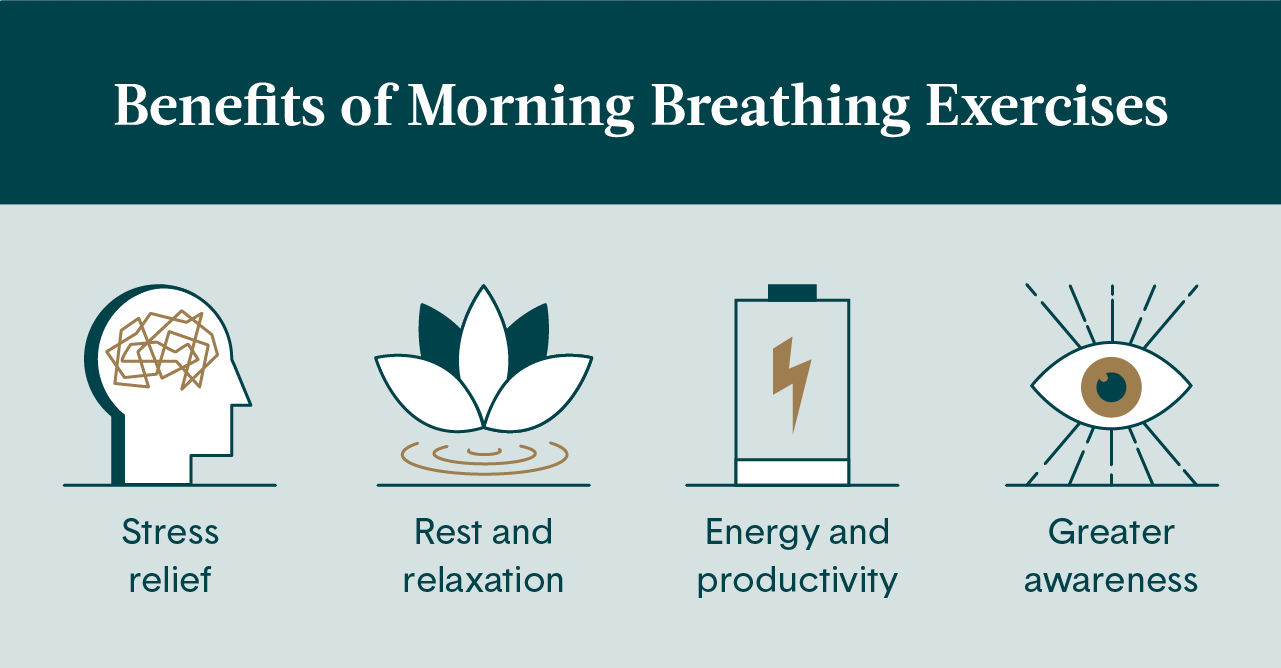
If your goals for practicing mindful breathing aren’t the same as everyone else’s, that’s okay! There are a wide variety of ways to integrate the practice into your life and reap its mental and physical rewards. Let’s take a look at a few of these benefits.
1. Relieves Stress
In addition to their mental and emotional stress-reducing abilities, breathing exercises help you control your body’s physiological responses to stress. For example, breathwork has been tied to lower blood pressure and increased oxygen levels.
Not only do these exercises relieve stress while you’re practicing them, but they provide you with a sense of control over your body and your stress response throughout the day.
2. Induces Relaxation
By turning your focus to one simple activity — breathing — you’re giving your mind a break from all the stimuli usually racing through it. Much like we do when we lie down for some beauty sleep, we’re communicating to our bodies that we’re ready to rest.
3. Energizes Mind and Body
Breathing exercises aren’t all used for winding down and relaxing — many are great energizers! Of course, the type of energy they provide isn’t to be mistaken for anxious or hyperactive energy.
When done right, breathing exercises should wake up your brain and prepare your body for movement while still giving you a sense of peace and confidence. You’ll enter your day feeling clear-headed and ready to accomplish your goals.
4. Promotes Awareness
At the core of pranayama and all breathing exercises is a greater sense of awareness. Breathing exercises are often considered a form of meditation, as they help us center our attention on the present moment. No past regret, no future anxiety — just our existence in the present moment.
How To Get the Most Out of Your Morning Breathing Exercises
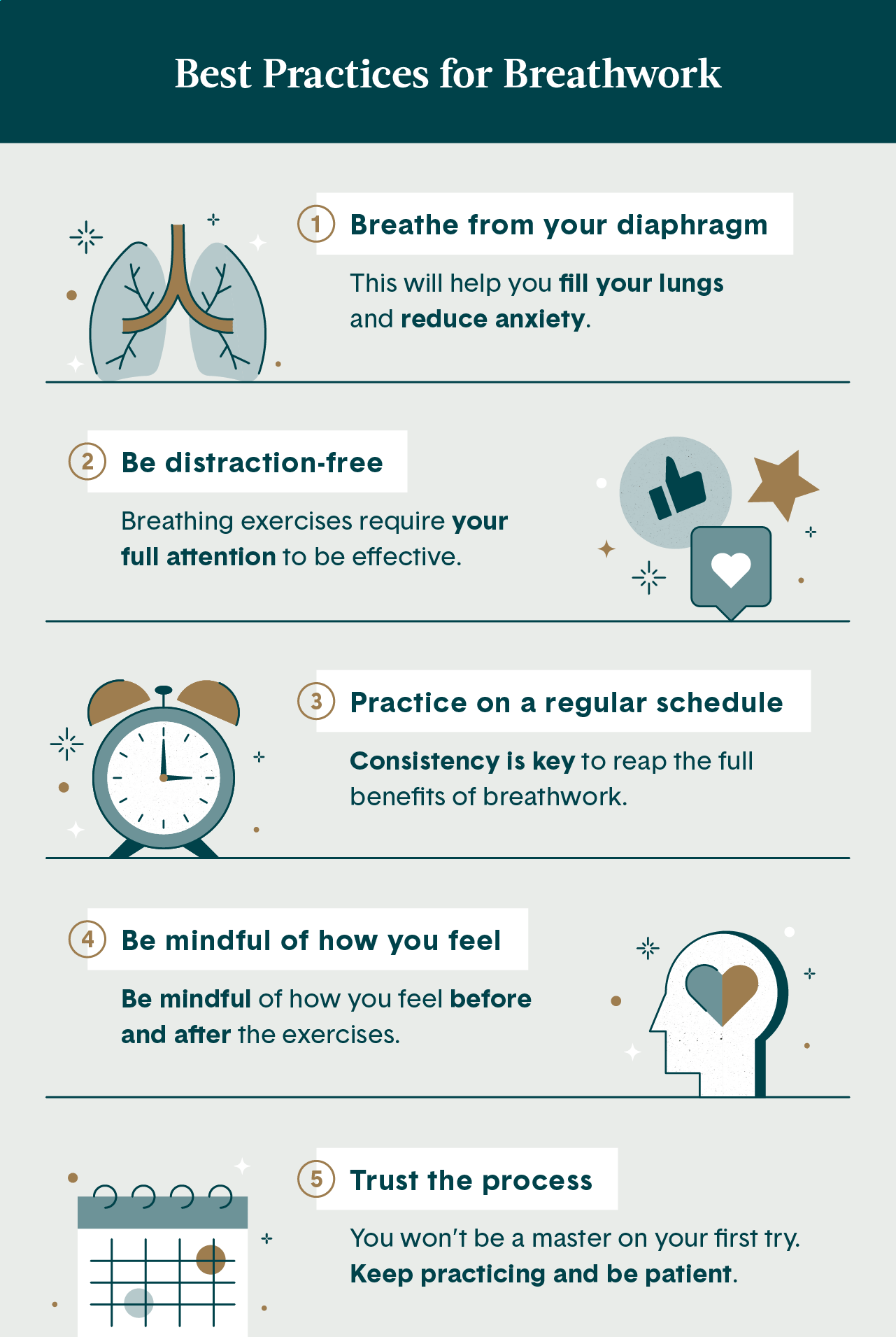
Before you dive right in and start practicing, there are a few best practices you should keep in mind to make sure you get as much out of the practice as possible.
- Practice diaphragmatic breathing: Shallow chest breathing can contribute to higher anxiety levels — it’s the kind of breathing we do when we feel panicked. When practicing breathwork, focus on diaphragmatic breathing. You should feel your stomach rising and falling and will likely feel much more control over your breath.
- Minimize distractions: A distraction-free space will allow you to focus on your breathing without getting sidetracked. After curating an ideal physical space for your practice, try keeping your eyes closed throughout it.
- Be consistent: Set aside a specific time to practice your breathing exercises every morning. Sticking to a schedule will make it easier to follow through and reap the full benefits of your practice.
- Compare how you feel before and after: It’s much easier to see how the practice is impacting you when you remember how you felt before starting and after you’ve completed a session. Consider using a journal to help keep track of this.
- Be patient: It’s okay if you don’t immediately connect with the practice. It can take several days and even months before you recognize what it’s doing for you. Keep trying new breathing exercises until you find the ones that work for you.
3 Breathing Exercises for Stress Relief
As we’ve established, breathing exercises can help regulate your body’s stress responses, releasing built-up tension. Whether you’re a student, a working professional, or a busy parent, try out the following breathing exercises that relieve stress before you start your day.
Belly Breathing
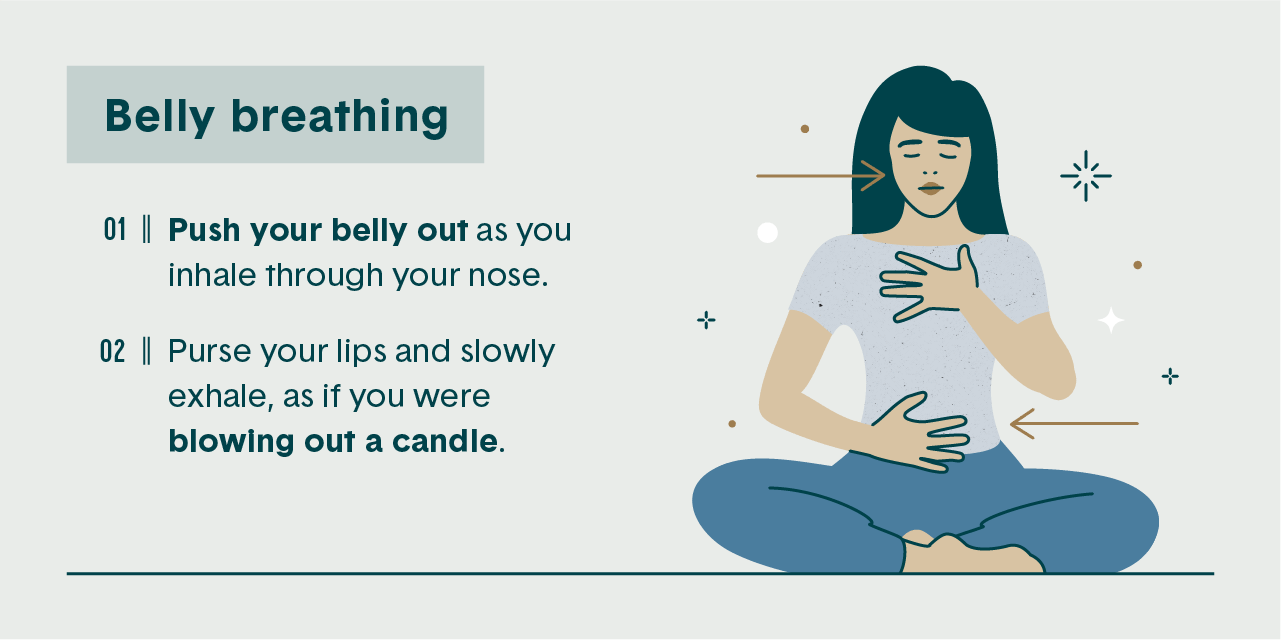
The belly breathing technique is a great way to practice diaphragmatic breathing, as it requires you to entirely focus on your diaphragm. It delivers the most oxygen to your lungs and helps relieve anxiety as well as symptoms of breathing illnesses (like asthma). You’ll find that many other breathing techniques model after belly breathing.
Follow these steps to learn how to belly breathe:
- Get into a comfortable position (preferably sitting or lying down).
- Rest 1 hand on your abdomen (right under your ribs) and the other on your chest.
- Inhale through your nose, pushing your belly out as you do so. Look down and make sure your chest is not moving.
- Purse your lips and slowly exhale, as if you were blowing out a candle. Once you exhale completely, use your hand on your belly to push out any remaining air.
- Repeat this process 3-10 times.
Three-Part Breath (Dirga Pranayama)

The three-part breathing method is a natural progression from belly breathing. The three “parts” of this exercise refer to the three parts of your abdomen that your breath enters: the lower belly, the lower chest, and the lower throat.
Regularly practicing this technique can help keep chronic stress under control and minimize the risk of panic attacks. Here’s how the three-part breath is done:
- Inhale through your nose, only expanding your belly to do so. Once again, keep your chest still.
- Exhale through your nose, using your abdomen muscles to push all of the air out of your lungs. Imagine your belly button touching your spine.
- Inhale through the nose again, expanding both your belly and your rib cage.
- Exhale through your nose, tightening your muscles to release all air from your rib cage and abdomen.
- Inhale through the nose once more, this time expanding your belly, your rib cage, and then your upper chest. You should feel your entire abdomen, from your belly to the base of your throat, expand with air.
- Exhale fully, until you’ve released all air from your body.
- Repeat the entire process 2-5 times.
Clearing Your Head
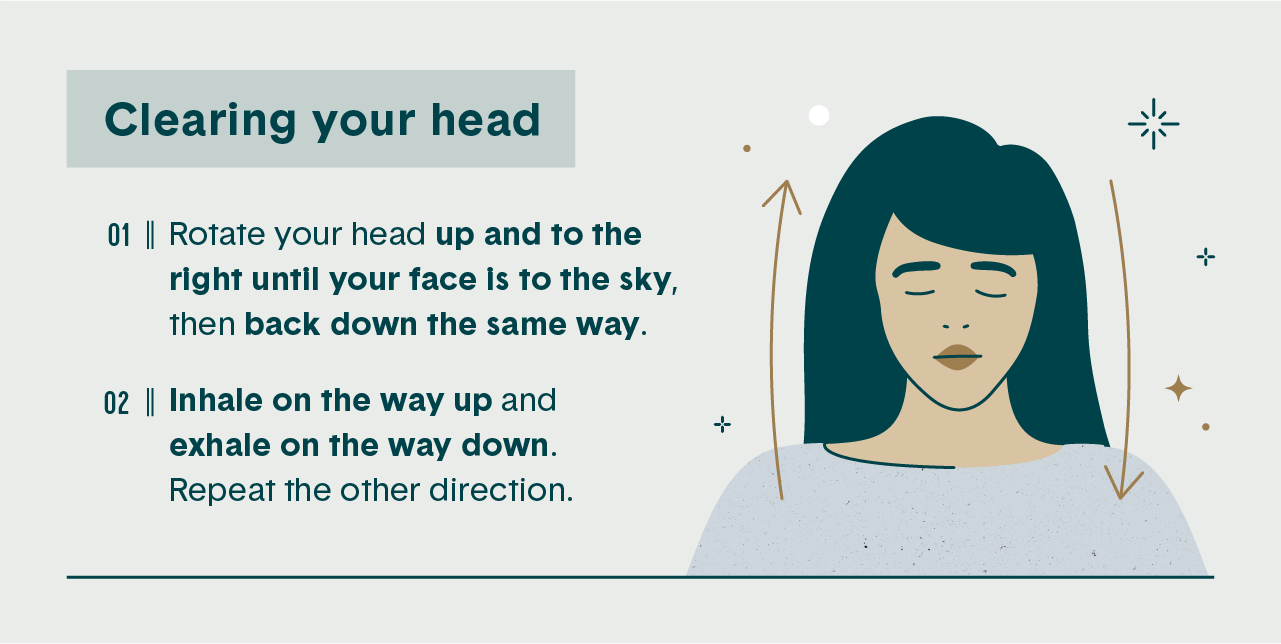
If you struggle with “tech neck” or tend to sleep on your neck wrong, this is the exercise for you. It’s great for both relieving neck tension and letting overwhelming thoughts go. This exercise begins with neck rolls — if you feel pain at any point during the exercise, pause and consider seeing a doctor.
Here’s how to perform the “clearing your head” breathing exercise:
- Rest your head in front of you, with your chin nearly touching your chest.
- Slowly move your head counterclockwise, or up and to the right. Inhale as you move your head, until your head is tilted back and you’re looking toward the ceiling or sky.
- Slowly return your head down and to the right (the same direction you came from), exhaling along the way. Release all air from your lungs by the time your head is back in front of you.
- Repeat the exercise, this time moving your head clockwise (up and to the left, then back again).
- Continue this exercise 3-5 times, or until you feel limber and calm.
3 Breathing Exercises for Relaxation
Another popular reason to practice breathing exercises is to integrate them into a meditative practice or a relaxation ritual. Yoga instructors often guide their students through them to encourage a sense of inner peace.
While you may not feel the need to relax right after waking up, starting the day with these exercises will help you stay relaxed once you’re faced with the day’s responsibilities.
4-7-8 Breathing
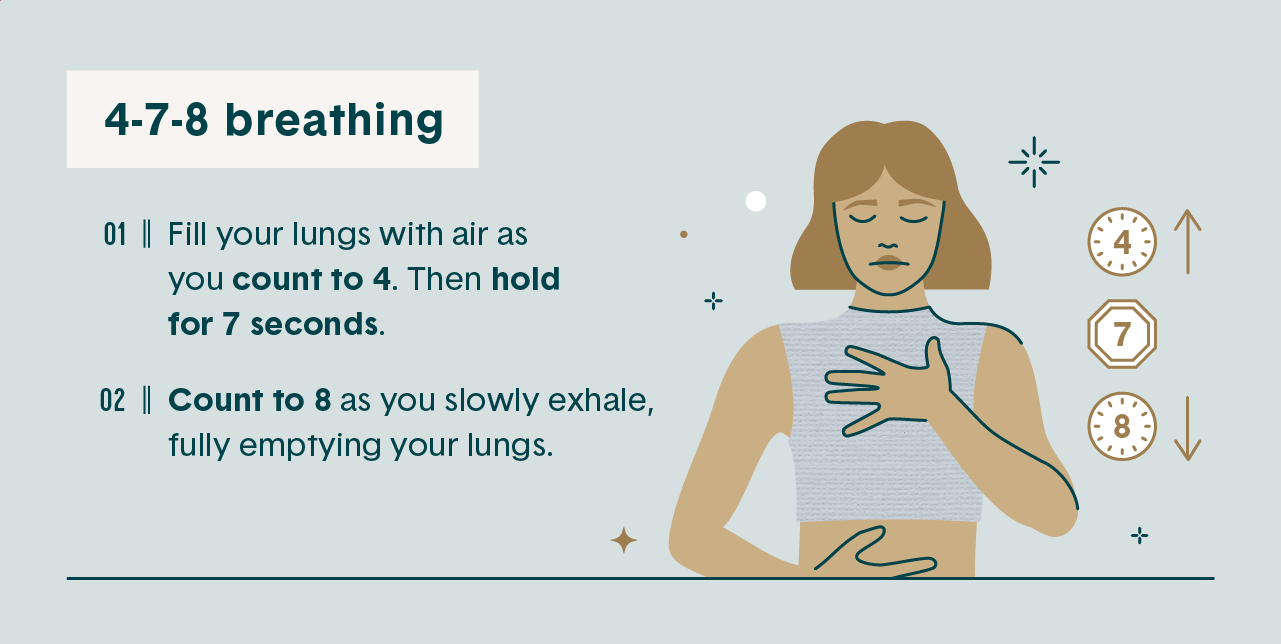
4-7-8 breathing is another exercise that builds from belly breathing. This exercise is great practice for controlling the speed, force, and movement of your breath. As a result, it’s perfect for anxiety management and rest.
The following steps will help you get started with 4-7-8 breathing:
- Rest 1 hand on your abdomen (right under your ribs) and the other on your chest.
- Inhale slowly using your diaphragm, counting to 4 in your head as you do so. Aim to fill your lungs completely by the time you count to 4.
- Hold your breath as you mentally count to 7.
- Count to 8 in your head as you slowly exhale. Aim to control how much air you’re releasing so that your lungs are empty by the time you count to 8.
- Repeat several times, or until your mind and body feel relaxed.
Roll Breathing (Abdominal Breathing)
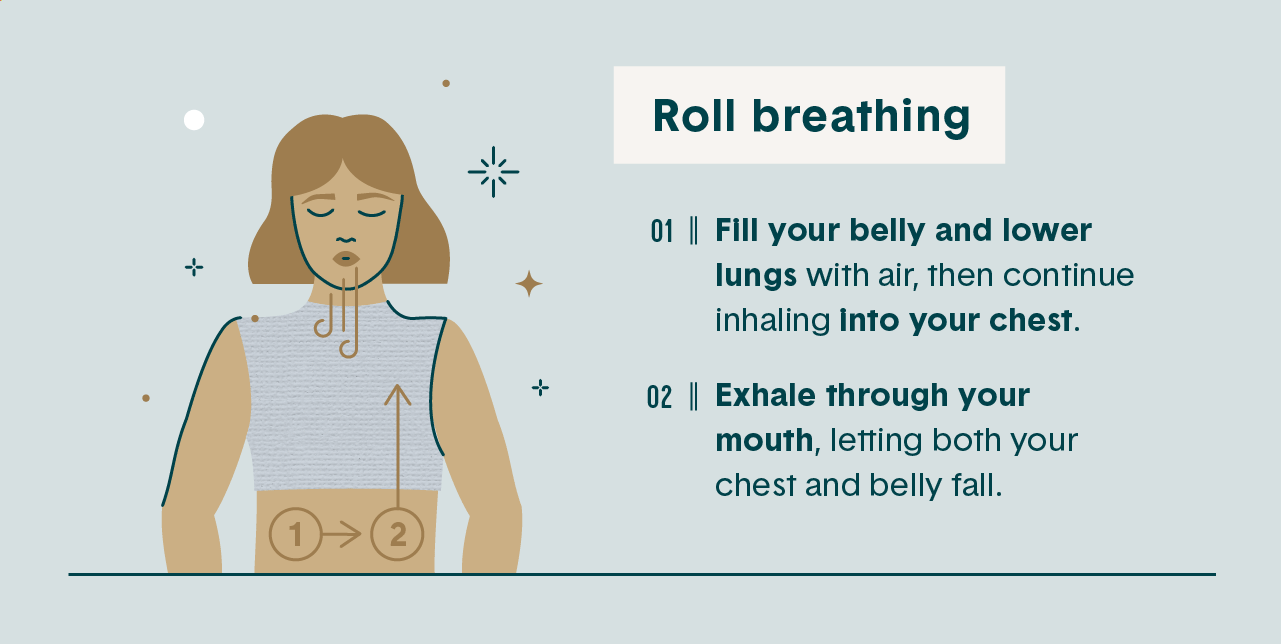
Roll breathing is another technique focused on paying careful attention to the rhythm of your breathing. After some practice, it should help you improve the strength and oxygen capacity of your lungs. This exercise will help you master deep breathing, a helpful technique for relaxation and anxiety relief.
To practice roll breathing, try the following:
- Place your right hand on your chest and your left on your belly. Pay attention to how they move throughout the exercise.
- Start by practicing belly breathing — only let your belly rise as you inhale through your nose, filling your lower lungs. Exhale through your mouth.
- Before continuing, be sure you feel comfortable with the motion in step 2. We recommend practicing this step at least 5-10 times.
- Inhale into your lower lungs again, raising your belly, but this time continue inhaling air into your chest. Notice your left hand rising then your right hand following.
- Slowly exhale through your mouth and make a whooshing sound, as if you were creating a small breeze. Imagine all the tension leaving your body with the whoosh.
- Practice this exercise for several minutes, until you feel confident you can do it without instructions. This is a great technique to have in your toolbox whenever you feel tense or anxious.
Box Breathing (Sama Vritti Pranayama)
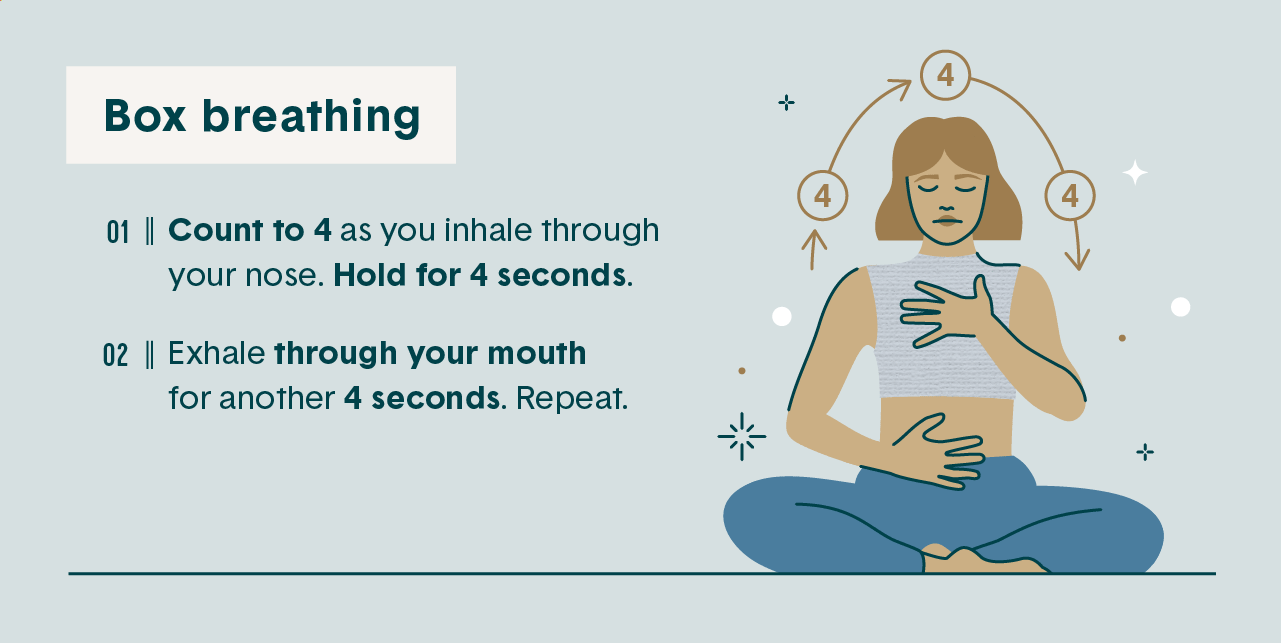
Also known as square breathing or equal breathing, box breathing is known to balance your body’s energy and induce calmness. Check out our box breathing printable to help guide you through the practice as you get started, or reference the steps outlined below:
- Place 1 hand on your chest and the other on your belly. This time, you’ll only want to feel your belly rise.
- Inhale through your nose as you count to 4.
- Hold your breath for 4 seconds.
- Slowly exhale out your mouth for another 4 seconds.
- Repeat this exercise as many times as you need to feel calm.
3 Breathing Exercises for Energy
You may want to learn morning breathing exercises to wake up and start the day feeling energized. If you aren’t naturally a morning person but want to begin your day on a productive note, the following exercises were made for you.
Morning Breathing
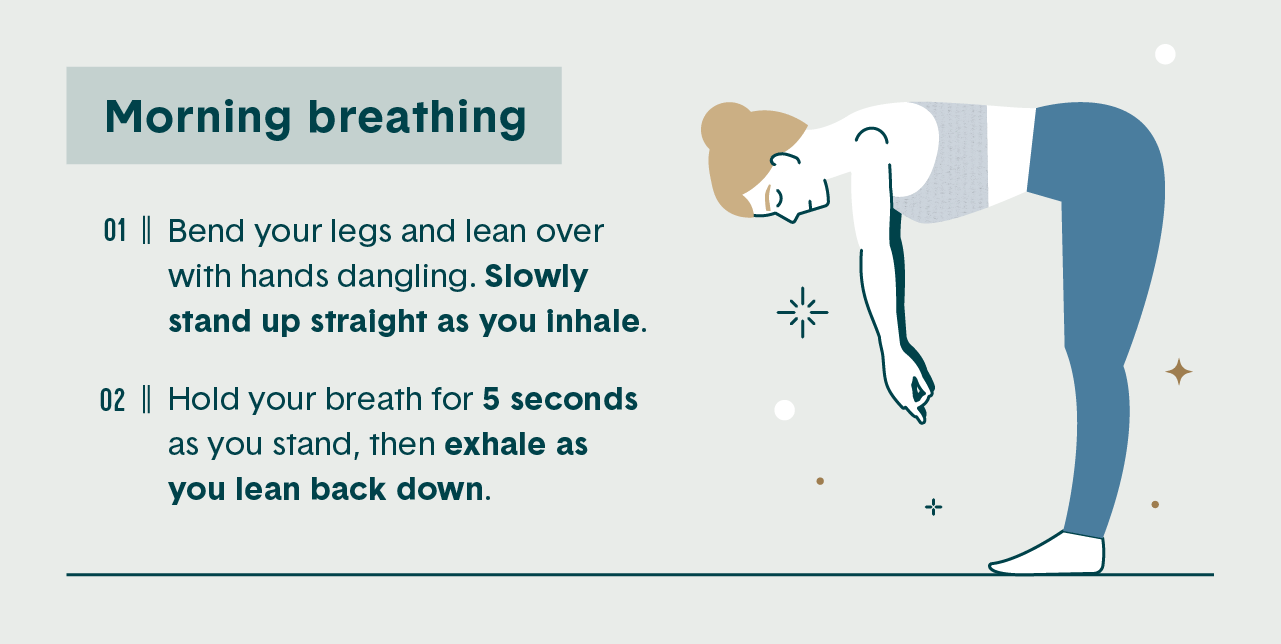
As the name suggests, this exercise is designed to be done as soon as you hear the birds chirping at the rising sun. It relieves muscle tension, opens up your breathing passages, and gives you the energy you need for the busy day ahead. Unlike the other exercises we’ve seen, this one requires you to start from a standing position.
Introduce morning breathing into your routine with the help of the following steps:
- Stand with your knees slightly bent.
- Bend your body forward at the waist, letting your hands dangle to the floor.
- Inhale slowly as you return your body to a standing position. Your head should be the last part of your body to reach an upright position.
- Remain standing and hold your breath for 3-5 seconds.
- Exhale slowly as you bend forward again, returning your body to the lower position.
- Repeat this exercise until you feel loose and refreshed.
Ocean Breathing (Ujjayi Pranayama)
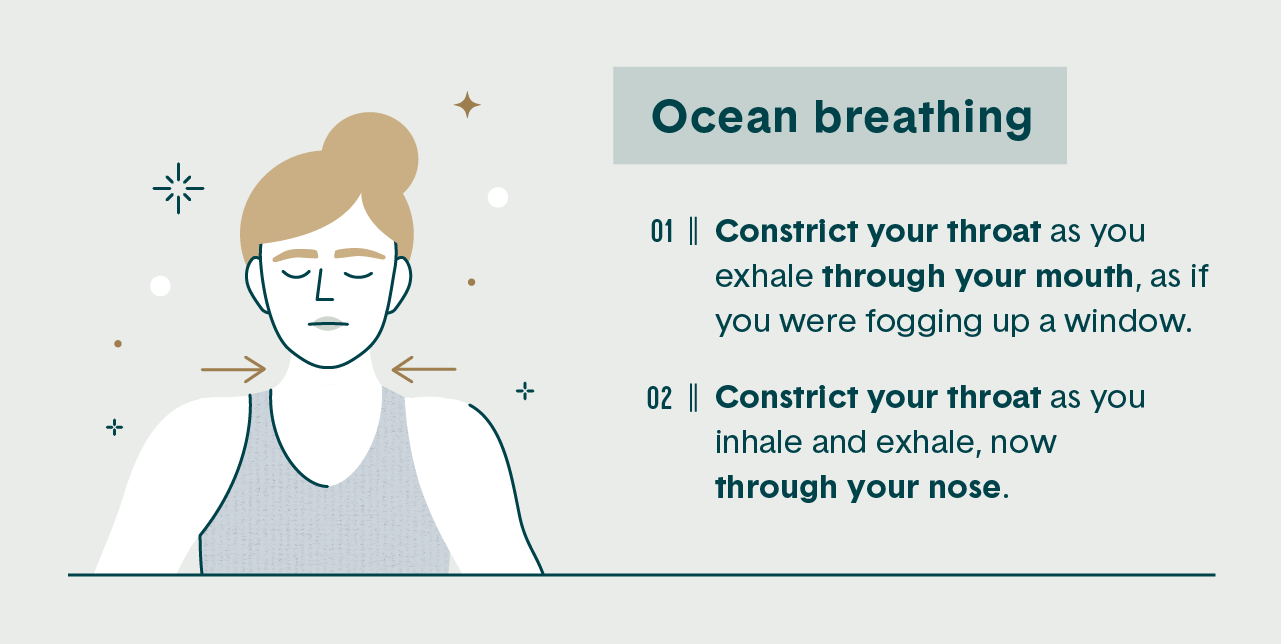
Up until this point, we’ve been focusing on the chest and belly. This next technique requires you to shift your focus to your throat. Ocean breathing is known to warm and energize the body. It also helps calm the nervous system and relieve any feelings of frustration.
To give ocean breathing a try, follow these steps:
- Practice breathing normally through your mouth for a few deep breaths.
- Breathe in through your mouth, filling your lungs.
- Slightly constrict your throat as you exhale. Notice the soft hissing sound you make as you do so. It should feel like you’re trying to fog up a window and sound similar to Darth Vader.
- Practice inhaling without constricting your throat then constricting as you exhale.
- Once you feel comfortable with the constricted exhale, try constricting your throat slightly as you inhale as well. This should make a sound that mimics the ocean — this is where the technique gets its name.
- Practice inhaling and exhaling like this through your mouth.
- Once you feel comfortable with this motion, begin breathing through your nose rather than your mouth, continuing to constrict your throat for both the inhale and exhale. You should still be making a similar ocean sound with your breathing.
- Continue practicing these steps until you feel energized and comfortable with the technique.
Skull Shining Breath (Kapalbhati Pranayama)
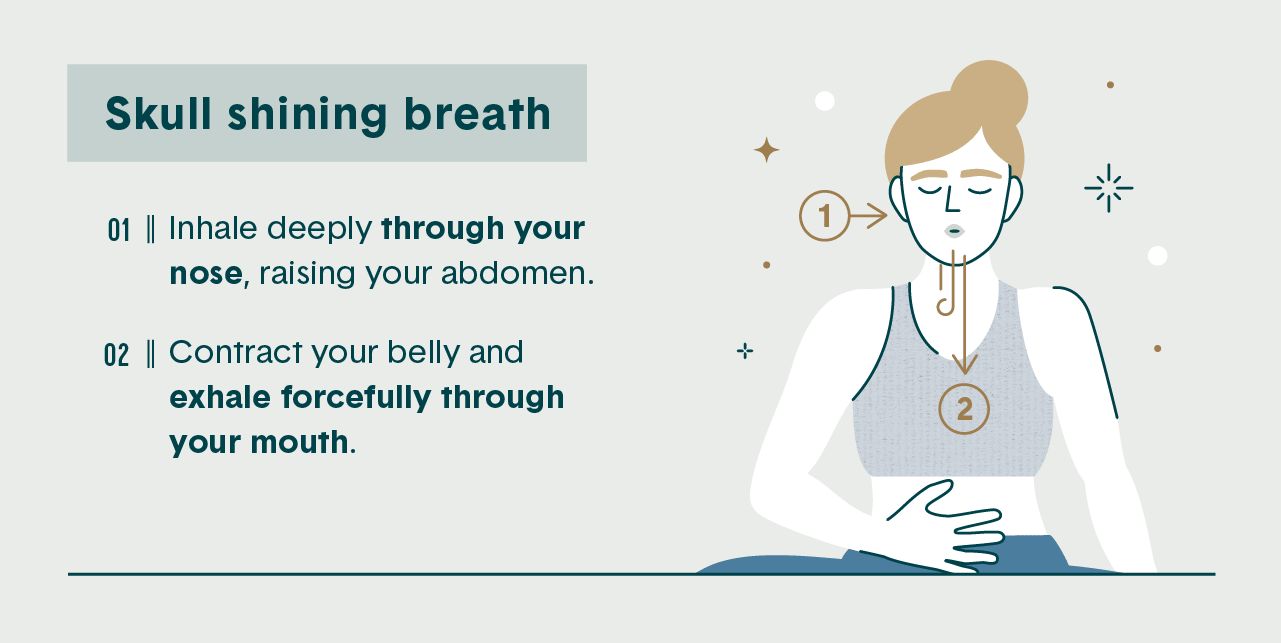
Also known as the breath of fire, the skull shining breath is perhaps the most energizing breathing exercise you can do. It is traditionally practiced to purify the mind and improve lung capacity. We recommend sitting up with a straight spine for this exercise.
Here’s how to start practicing the skull shining breath:
- Rest 1 hand on your stomach.
- Take a deep breath through your nose, feeling your abdomen rise.
- Contract your belly on the exhale, pushing your breath out of your mouth in a short burst, as if you were blowing out a candle.
- Relax your abdomen and breathe normally.
- Repeat this exercise until you feel mentally and physically invigorated.
Morning breathing exercises are a great way to begin the day mindfully. Whether your goal is to relieve stress, kick back, or enhance your productivity, there are exercises for everyone.
If you’re ready to take your mindful breathing journey to the next level, grab some comfy pajamas and download our infographic on morning breathing exercises below.


